
Podcasting Mic Boom Arm Shootout
Wednesday, May 30th, 2012 | by matthew mcglynn
If you do much Skyping or podcasting, you’ll soon outgrow your desktop microphone stand.
Maybe you’ll get by with a boom arm on a floor stand, at least until you trip on it a few times when you get up from your desk. The problem with both those solutions is that whenever you’re not using the mic, it’s in the way. Also, neither a desktop stand nor a floor stand will let you easily adjust the mic’s position if you move during the broadcast.
The best solution to all these problems is to mount a boom arm on your desk. This is not a new technology; radio jockeys have used these for years. There are a handful of such devices on the market; in this review, I’ll test five models from K&M, MXL, Rode, and Heil. I’ll identify my favorites, and detail the strengths of all these stands for those whose needs differ from my own.
Test Methodology
This shootout includes the following five boom arms:
I mounted each stand on my desk, in turn, and hung an  Electro-Voice RE20 from it. This is not only an industry standard broadcast mic; it also was the Reader’s Choice winner in the Ultimate Podcast Mic Shootout.
Electro-Voice RE20 from it. This is not only an industry standard broadcast mic; it also was the Reader’s Choice winner in the Ultimate Podcast Mic Shootout.
All five boom arms supported the weight of the mic without sagging. The observations below describe each arm’s strengths and shortcomings, relevant accessories, and ease of operation.
Click the thumbnail photos below to zoom in.
Heil PL-2T
 |
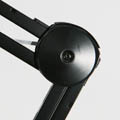 |
 |
 |
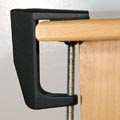 |
 The Heil boom arm, along among these products, provides the neat feature of allowing a separate mic cable (not included) to be strung inside the device. The cable can be hidden with snap-in plastic covers, resulting in a professional and clean look.
The Heil boom arm, along among these products, provides the neat feature of allowing a separate mic cable (not included) to be strung inside the device. The cable can be hidden with snap-in plastic covers, resulting in a professional and clean look.
Although most of the other boom arms reviewed here come with mic cables pre-installed, I prefer Heil’s approach, simply because I wouldn’t want to have to replace the entire arm if the cable gets run over by someone’s chair a few times too many. I’d much rather replace just the cable, but it’s not clear this is possible for arms whose cables are embedded at the factory.
The desktop clamp on the Heil stand is solid, and turns out to be the best of the bunch. In testing, it had the deepest, most certain grip, and was easy to adjust. It is made of metal, with a T-rod for tightening and a bare metal cup to press against the underside of the desktop. It is simple and effective.
In use, the PL-2T is nicely balanced. It’s not springy at all, but does offer some resistance to movement. Once moved, the mic stays where it gets put, although it wobbles side-to-side briefly when released.
My PL-2T squeaks when the middle hinge is moved. I assume it can be oiled, but I think new hardware shouldn’t need maintenance out of the box.
Overall, I grade the PL-2T as an “A-.” It is a little stiff, but is clearly a professional-quality device. I have no qualms about recommending it for broadcasting or podcasting applications. Once properly lubricated, it would merit an “A.”
K&M 23860
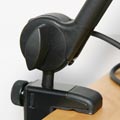 |
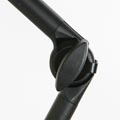 |
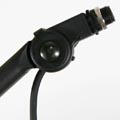 |
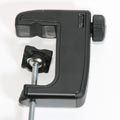 |
 |
 The 23860 is a slick-looking boom, with a unique design among all the stands tested here. Each arm is a single enclosed piece, with circular hinges providing good range of motion and excellent horizontal reach despite its relatively compact size.
The 23860 is a slick-looking boom, with a unique design among all the stands tested here. Each arm is a single enclosed piece, with circular hinges providing good range of motion and excellent horizontal reach despite its relatively compact size.
The arm has an embedded cable, a supple oxygen-free copper variety from Schulz Kabel in Germany. The connectors are Neutrik’s basic “X” series (NC*MX male, NC*FX female).
I do not like the clamp. Although burly in appearance, it fails to grip the desktop securely. Despite progressive tightening of its knob, it slipped off the desktop in several tests.
The lower jaw is topped with a rigid plastic pad that does not grip the underside of my desktop — or, perhaps it just requires more pressure than the knurled tension knob can comfortably apply. It is designed to allow mounting on tubes as well as flat surfaces, but in my experience, it did a poor job on my desktop. If you buy this boom arm (or the 23850), I recommend also buying K&M’s screw-mount flange, p/n 23855.
I find this boom arm to be temperamental and hard to use. Out of the box, the internal springs apply more lift than my mics require. I was able to loosen the metal tensioning belt by one notch, to its loosest setting, via an adjustment plate near the lower joint. The arm was slightly better behaved afterwards.
The spring tension can be further adjusted via external knobs at each joint, but tightening these also makes the stand overly stiff and difficult to reposition. Finding the minimum amount of tension necessary to keep the stand from springing the mic away proved challenging, because too much tension makes the arm so stiff that repositioning the mic breaks the clamp free of the desktop.
The mechanism is quiet, and does keep the mic where it gets put, subject to the comments above about finding the right amount of spring tension.
One other aspect of this arm’s performance worth noting is that the mic’s angle is fixed, relative to the top arm of the boom. If you raise the mic very far, it will be pointing at the ceiling, unless you have a yoke mount for the microphone itself. All the other boom arms tested here keep the mic at a constant angle relative to the floor, even as the arm is raised.
One nice feature of this arm is that the aforementioned tensioning knobs can be tightened to lock the arm into position. The arm can still rotate across the desk, but vertical movement and extension would be effectively locked.
If you’re setting up a fixed installation, or using a very heavy microphone, the 23860 is a good choice. It is strong, it looks great, and it would be easy to keep clean. Yet it seems overbuilt for desktop applications, and is somewhat unaccommodating of light microphones and applications where the mic would be frequently repositioned. As shipped, I rate it a “B-” for desktop broadcasting.
K&M 23850
 |
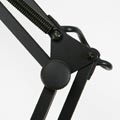 |
 |
 |
 |
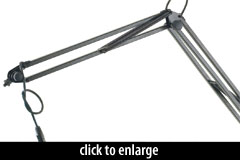 The 23850 is the more industrial looking of König & Meyer’s two boom arms. Like its sibling, it has a captive mic cable, although this one is K&M’s house brand rather than the upscale Schulz OFG found in the 23860.
The 23850 is the more industrial looking of König & Meyer’s two boom arms. Like its sibling, it has a captive mic cable, although this one is K&M’s house brand rather than the upscale Schulz OFG found in the 23860.
Both K&M arms use the same clamp. I liked this clamp even less after testing the 23850, because it slipped off my desktop and dropped my RE20 on the floor.
The 23850 proved easier to adjust and manipulate than the 23860. The 23850 is smoother and easier to move than the Heil unit, too. The mic goes where you want it, and stays where it’s put. The arm is essentially silent to operate, although occasionally one of the springs would bind on its mount and then clangggg loudly.
The build and finish quality of the 23850 are excellent. The arm has a 5-year warranty, which I don’t imagine many customers need to exercise; this unit seems likely to provide many years of reliable service.
Overall, I grade the 23850, with its table clamp, a “B+.” The boom arm itself, if used with a better clamp or with K&M’s flange mount, merits an “A.” It has a few performance glitches, but is solidly built, will likely last forever, and provides generally quiet one-hand operation.
MXL BCD Stand
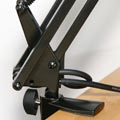 |
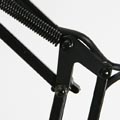 |
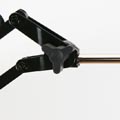 |
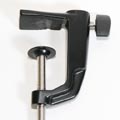 |
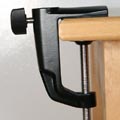 |
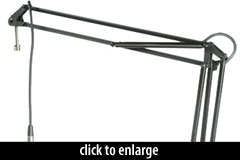 The MXL BCD-Stand is a scissor-style stand, like the K&M 23850. It is a lighter weight design than the K&M, with square steel tubes measuring about 9.5mm across (as compared to the 12mm tubes in the 23850).
The MXL BCD-Stand is a scissor-style stand, like the K&M 23850. It is a lighter weight design than the K&M, with square steel tubes measuring about 9.5mm across (as compared to the 12mm tubes in the 23850).
The BCD Stand has a captive mic cable. I expected MXL to use its house brand, Mogami, but the unit tested showed no brand, only the “professional low noise microphone cable” legend familiar to users of inexpensive imported tube microphones.
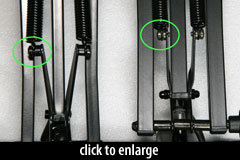 My BCD had a minor defect: the lower spring mount was too wide for the lower frame to swing past it. This cut the unit’s horizontal reach in half, because the lower arm could not extend past vertical.
My BCD had a minor defect: the lower spring mount was too wide for the lower frame to swing past it. This cut the unit’s horizontal reach in half, because the lower arm could not extend past vertical.
According to MXL, this condition is rare, and can be quickly remedied by squeezing the tabs on the spring mount together. They’re right — I fixed mine easily, no tools required.
The table clamp is a simple, low-profile design with a bare metal cup on the lower jaw. It has the best T-bar handle of all the models tested. The mount was secure in my tests, but the metal cup on its lower jaw sits very close to the curved edge of my desktop. The clamp’s grip would be improved if the lower jaw reached further under the desktop (as does the Heil clamp), centering it beneath the top jaw.
The BCD Stand gets extra points for including a screw-on flange mount for permanent installations.
In operation, the BCD Stand is generally smooth and quiet, with a bit more resistance than some of the other models here. The lower pair of springs creates occasional spring noise when the arm is extended, but (as with the 23850) it is not significant.
The arm’s lightweight construction (compared to the 23850) did not prevent it from working well with my heavy broadcast mics. For lighter mics, a knob on the middle joint can be tightened to reduce the springiness of the top arm.
For desktop broadcasting applications, I grade the BCD Stand a “B+.” It is a competent desktop boom arm at an entry-level price.
Rode PSA-1
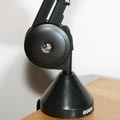 |
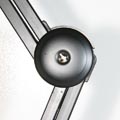 |
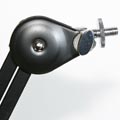 |
 |
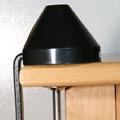 |
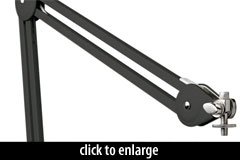 The PSA-1 has a design similar to the Heil, in that the pairs of arms are arranged top-and-bottom rather than the “scissor” design of the K&M 23850 and MXL. The spring mechanism is embedded within the arms of the device. The PSA-1 is a bit more compact than the PL-2T, but provides nearly as much horizontal reach.
The PSA-1 has a design similar to the Heil, in that the pairs of arms are arranged top-and-bottom rather than the “scissor” design of the K&M 23850 and MXL. The spring mechanism is embedded within the arms of the device. The PSA-1 is a bit more compact than the PL-2T, but provides nearly as much horizontal reach.
The Rode table clamp is functional, but consumes more of the desktop surface than competing designs. The clamp itself is strong and secure, but from an aesthetic perspective I prefer the lower-profile Heil clamp.
The PSA-1 does not come with an embedded cable, nor Heil’s “topless” design, but does include Velcro cable ties so that your cable can be routed neatly down the arms of the unit.
The top joint, as with all other models here besides the K&M 23860, keeps the mic’s angle consistent (relative to the floor) as the mic’s height is adjusted.
In use, the PSA-1 is relatively smooth and quiet. It is less stiff than my Heil PL-2T, facilitating one-hand operation. It doesn’t squeak, but emits an occasional mechanical rubbing noise during height adjustments. These noises are unlikely to be audible during broadcast.
I like the PSA-1. Beyond my aesthetic quibbles with the clamp, it gives me everything I would want from a desktop boom arm. I grade it an “A.”
The PSA-1 and PL-2T are so similar, I ended up mounting them side-by-side for a final comparison. The differences are subtle; if you already own one or the other, you need not switch. The Heil has a better clamp, a bit more reach, and an internal cable track. But it is stiffer. The Rode is smoother to operate, and wobbles less afterwards. If you’ve narrowed your selection down to these two, you might as well shop by price.
Comparison Table
| K&M 23850 | K&M 23860 | MXL BCD-Stand | Heil PL2T | Rode PSA-1 | |
| Clamp Mount |
included | included | included | included | included |
| Screw Mount |
available | available | included | available (2) | included |
| Captive Cable |
yes | yes | yes | no | no |
| Max Horiztal Reach (in) |
36 | 33 | 33 | 33 | 31 |
| Max Vertical Reach (in) |
37 | 35 | 36 | 37 | 34 |
| Lower Arm Length (in) |
19.5 | 16 | 19 | 19 | 16 |
| Upper Arm Length (in) |
19 | 16.5 | 18.75 | 18 | 15.75 |
| Max Load (g) |
800 | 1500 | ?? | 1100 | 1100 |
| Mic Mount Threads |
Euro | Euro | US | US | Euro |
| MSRP | $199.99 | $349.99 | $99.99 | $120 | $109 |
Summary
The five boom arms reviewed here can be grouped by design. I found the Heil/Rode design superior for my application; both these boom arms are compact and neat without sacrificing range of motion or ease of use.
The “scissor” design is bulkier, but can be capable of smoother operation, and offers external tension adjustment. Due to the exposed springs, though, this design is potentially noisier, although in practice these stands tended to be quiet.
The 23860 is a unique design. It is the nicest looking of the bunch, and has the highest weight rating, but proved difficult to use in my testing. With a heavier microphone, this arm might work better, and in fact if your mic plus shockmount weigh more than 2.5 lbs, this stand is your only choice. And while I generally don’t prefer to have cables embedded within the stand, I commend K&M for including a high-end cable in the 23860.
Based on price, features, and operation, I give the Rode PSA1 a RecordingHacks Editor’s Choice award. It will provide the vast majority of boom arm users everything they need for podcasting, broadcasting, or Skyping. It includes a flange mount as well as a clamp, and costs less than the Heil PL2T. Consider the PSA-1 “highly recommended.”
The Heil PL2T deserves an honorable mention here. I like its innovative “topless” design that allows the mic cable to be hidden. I like that Heil makes a flange mount, embeddable desktop screw mount, wall mount, and an extension bar, all available separately. Heil even makes a counterweight that bolts to the threaded rod where the mic attaches, making the arm more balanced when used with lightweight microphones. Consider the PL2T “highly recommended” as well.
Update, 2012-11: Both the PSA-1 and PL-2T have been listed in our new guide, RecordingHacks Editors’ Choice: Podcasting Gear
For broadcasters with budgetary challenges, the MXL BCD Stand is a great deal at its typical street price of $70 — including a mic cable! It doesn’t match the build quality of the K&M 23850, but for light-duty use it will work fine.
If you’re shopping, please consider buying from the links on this site, as the small commissions generated thereby help offsite the considerable expense of reviewing all this gear.
Find all 5 of the boom arms reviewed here on sale at B&H, in the widget below:
A note about noise
Every one of these desk-mounted booms shares a potential problem: they will transmit any noise from your desk directly to the microphone. If, for example, you have a disk drive or CPU sitting on your desk, the vibrations and fan noise will be mechanically transmitted with shocking efficiency to your mic.
Read more about this in my article on How to Fix Microphone Hum.
In short: use a shockmount for your mic, or better yet, decouple the CPUs and disk drives on your desktop by putting them on vibration-absorbing feet (click the article link above for a specific product recommendation).
Desktop boom arms are a big win for convenience, but do carry the risk of inducing noise to your voice track that a heavy floor stand would not.
Credits and Disclosures
The Heil PL2T reviewed here is my personal property (purchased online). The K&M stands were provided on an evaluation loan by US distributor Connolly Music. The Rode PSA1 and MXL BCD stands were provided on an evaluation loan by their respective manufacturers. I thank the folks at Connolly Music, MXL, and Rode for the use of loaner gear that shall be returned shortly (except for the PSA1; see below). I received no compensation for this review.
Comments?
Love ’em or hate ’em, what do you think of your boom arms? I’m especially interested in feedback about the longevity of these stands — if you’ve used one for a while, please let us know how it is holding up.
Take one home?
The kind folks at Rode generously donated the PSA-1 reviewed here as a giveaway prize. The winner was chosen on June 15, 2012.
Need a podcasting mic too?
Hear the Shure SM7B and SM57, Heil PR40, beyerdynamic M99, ElectroVoice RE20 and RE320, and Sennheiser MD421 in the Ultimate Podcast Mic Shootout. These are the best radio microphones ever made. One of these is sure to work great for your podcast. Assuming you have a mouth, I mean. 😉
Posted in Podcasting, Reviews, Shootouts, voiceover | 24 Comments »
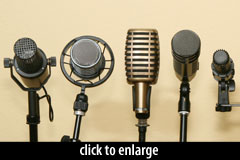
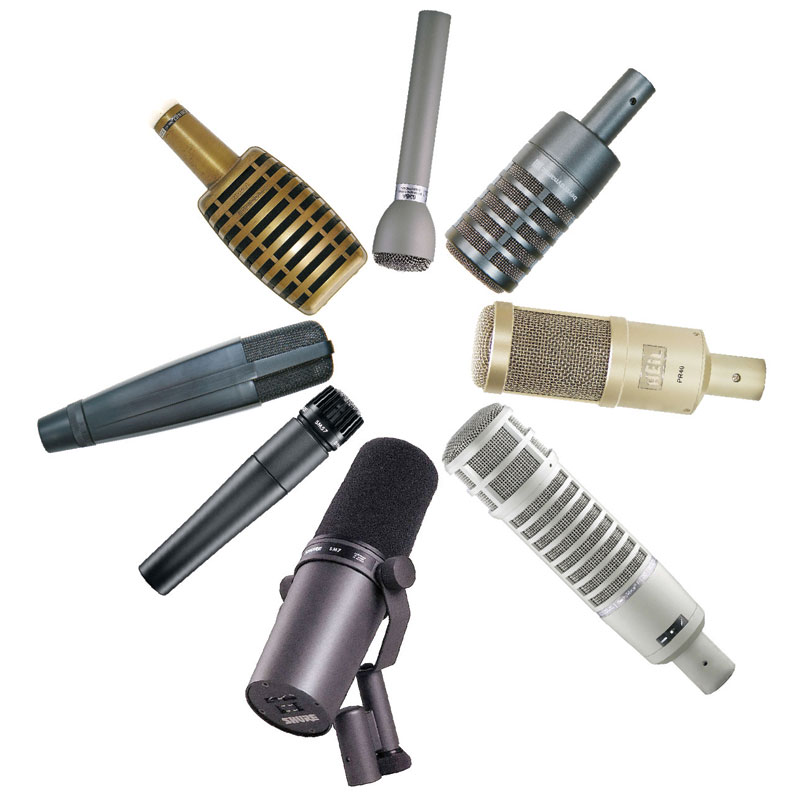
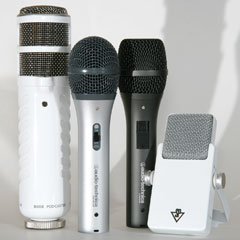


Mike Sorensen
May 31st, 2012 at 12:41 am
Man you take understanding of microphones to a whole other level Matt – I love it. We’ll have to find a way mix our sound diffusion technology with your mic expertise somehow – the world won’t know what’s hit em! 😉
Have a great day
Mike
Jeff Hawkins
May 31st, 2012 at 5:15 am
This was very helpful in deed. I was looking for a good desk arm and this has made my choosing so much easier, Thanks! Nicely done!
Jeff Hawkins
Darren Morton
May 31st, 2012 at 2:40 pm
How come the radio-standard, YellowTec boom wasn’t included in this test? That boom is in a league of its own. http://yellowtec.com/index.php?id=micarm-fe
matthew mcglynn
May 31st, 2012 at 3:40 pm
@Darren, neither Yellowtec nor O.C. White had come up in my initial searches or inquiries. But then this was never intended this to be an all-inclusive review anyway.
I think the Yellowtec gear is better suited to permanent installations (e.g. in broadcast studios). Their clamp is incompatible with my desktop, which would have made it hard to test. Also, knowing what I now know about all the competing models, I have a hard time believing Yellowtec’s $325 arm ($275 for the arm + $50 for the clamp) would be materially better for home broadcasting applications.
Darren Morton
June 1st, 2012 at 5:47 am
Agreed – it ain’t cheap. On the flip side, the radio studios I’ve built or serviced over the years that utilized table-top clamps all abandoned them because they work loose from repeated use and typically end up scoring the counter top material as they escape the clutches…so to speak. That said, boom arms in general have collectively evolved nicely from the old, Luxo products we had to deal with 20-yrs back that were barely sturdy enough to support a grad student’s desk lamp in a dorm room…
Paul Strikwerda
June 4th, 2012 at 7:19 am
Thanks for this terrific shootout, Matt. I have been thinking of buying a boom arm and I just didn’t know which one to choose.
Can a shock mount be easily attached to all these models?
matthew mcglynn
June 4th, 2012 at 7:28 am
Paul, it is easy to attach a shockmount. The only possible caveat is that the K&M and Rode stands use the european thread size. They come with adapters, but the adapter adds another layer of interface to fiddle with — these adapters invariably stick to the shockmount when the shockmount is removed from the arm. If you change or move mics frequently, this might become a consideration.
Geoff Bradley
June 4th, 2012 at 4:17 pm
I could really use a boom stand….
Judson Voss
June 12th, 2012 at 11:40 am
Great review. I made it 6 years podcasting/recording on an almost daily basis without a boom arm and now you gave me the itch. Might have to snag a PL2T. Any experience with the Heil HB-1?
Nigel Lambert
July 28th, 2012 at 12:58 pm
Great article, but whatever you do – DON’T TRY AND LUBRICATE THE HEIL IF IT SQUEAKS!!! I squirted some WD40 to try and eliminate a small spring squeak, and virtually ruined it! I have no idea why oil should affect the arm that way, but the tension simply disappeared. Heil kindly replaced the arm under warrenty – but be warned, oiling causes disaster!!
Nigel Lambert
Gabriel
January 15th, 2013 at 8:38 am
Are any of these boom arms (especially the Rode) compatible with a mic like the Shure SM57, or only broadcast microphones?
matthew mcglynn
January 15th, 2013 at 8:53 am
@Gabriel, all of these arms have a standard threaded rod at the end. Any mic clip can be attached, including the plastic one that comes with the SM57.
See the second-to-last row in the comparison table, “mic mount threads.” I used the terms “US” and “Euro” as shorthand for these numbers that I can never remember, but just looked up:
“US” standard is 5/8 inch, 27 threads per inch
“Euro” standard is 3/8 inch, 16 threads per inch
Just about every microphone I’ve ever bought had a mic clip tapped for 5/8-27, plus a separate adapter allowing attachment to 3/8-16.
So, in short, all of these boom arms will work fine with any standard mic clip.
Gabriel
January 15th, 2013 at 9:07 am
Awesome! Thanks, Matthew! Great stuff.
Daniel
April 23rd, 2013 at 5:30 am
@Nigel, it was recently pointed out to me when talking about bicycle chains that WD-40 isn’t what you want to use to keep one lubricated. WD-40 is good at getting rusty things moving again, but lubrication oil is what you want to use to keep things from squeaking and running nicely.
Joe
May 30th, 2013 at 6:40 pm
Hi there,
I found this review very helpful. I have a question though: My table top is thicker than 1.5 inches and I’m looking for a clamp that will have the capacity more than 1.5 inches and will fit the boom HB-1 for Heil PR40?
Thanks
Joe
Michael
June 15th, 2013 at 6:01 am
Thanks so much for putting this review together. I have a Rode “podcaster” Mic with a traditional metal stand. Yes indeed, it gets in the way! For the uninitiated it is difficult to figure out what these are even called. Booms, swing mic’s? “Clamp Mount Mic Boom” amazon search finally produced “Microphone Suspension Boom Scissor Arm Desktop Stand Shock Mount” Which finally got me here, so I could finally nod my head and say yeah, yeah, I knew that, Uhuh! Thanks, Michael Brown
Dan Ortego
August 15th, 2013 at 8:54 am
While I read the various posts and I realize why YellowTec wasn’t included. However, I don’t understand why O.C. White components were not included as they are quite popular and relatively affordable when compared to Rode and Heil.
In fact, I continually read reviews with the aforementioned boom armatures becoming weak, lose, or just flat out fragile. Like most anything else there’s a bit of trial and error to selecting the right boom arm and I have certainly had my share of shipping cost to return items that didn’t quite fit or just didn’t suit my taste.
In the end, I opted for the O.C. White 45-inch extended reach arm with a 15-inch riser. It’s designed to be bolted to the desk although I’m currently using two small c-clamps that work just fine. Once I’m certain of its location all take to the drill.
Reginald
December 26th, 2013 at 6:26 am
Hello and thanks for the review. I just purchased the RE20 mic with the 309 shock mount. I like the Rode PSA-1 and the Heil swing arms (leaning more towards the Heil). But I was wondering if you know if the Heil (or the Rode for that matter) will support the weight of the RE20 and shock mount?
Thanks
matthew mcglynn
December 26th, 2013 at 10:20 am
@Reginald, my test used an RE-20. All these mounts could carry that mic, with the caveats stated above. I didn’t have a shockmount on there too, but you can see the “max load” specifications in the table above.
Ben
January 7th, 2015 at 12:20 am
The max load is wrong. PSA1 can take 4.4 pounds.
Please update review
March 10th, 2015 at 12:41 pm
Please update your review. It’s been a while. For the price it seems like the MXL-BCD-STAND is the way to go. Many of us need the height and length to be a crucial part of our decision process. The fact that some come with risers is important. Also mention that any riser requires a drill. None of the booms I’ve seen some with a table clamp with use of a riser. Helpful information though. Thanks
festus
April 21st, 2015 at 5:53 pm
I’ve spent a lot of time reading about arms and firstly it’s weird how it long takes before you peel below the top layer of crap cheaply produced rubbish and get to the better stuff….
I have a Rode NTK approx 0.76kg with the Rode SM6 mount 0.68kg, so a weighty combo at 1.44kg. It’s clear from reviews that the PSA1 mount is just not strong enough with many saying it completely flopped despite what Rode says. It’d be nice to see another shootout with the higher rated mounts. If not an additional heads up for what names to look for if you need something stronger.
Good write up
festus
April 22nd, 2015 at 10:14 am
Couple more things:
**The Rode arm CANNOT take what Rode advertise it can** There are many reviews from users of heavy weight combos that their boom failed with.
Also if you’re experiencing noise from joints on your boom, DO NOT use WD40 or any other kind of solvent as could damage plastic/rubber washers. Use a tiny amount of grease.
DenisinWales
January 8th, 2016 at 2:15 am
Many thanks for an outstanding comparison article. I am grateful for your efforts here. Full marks.